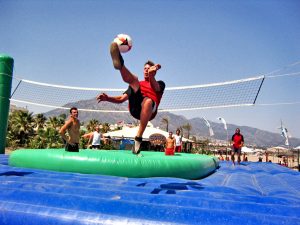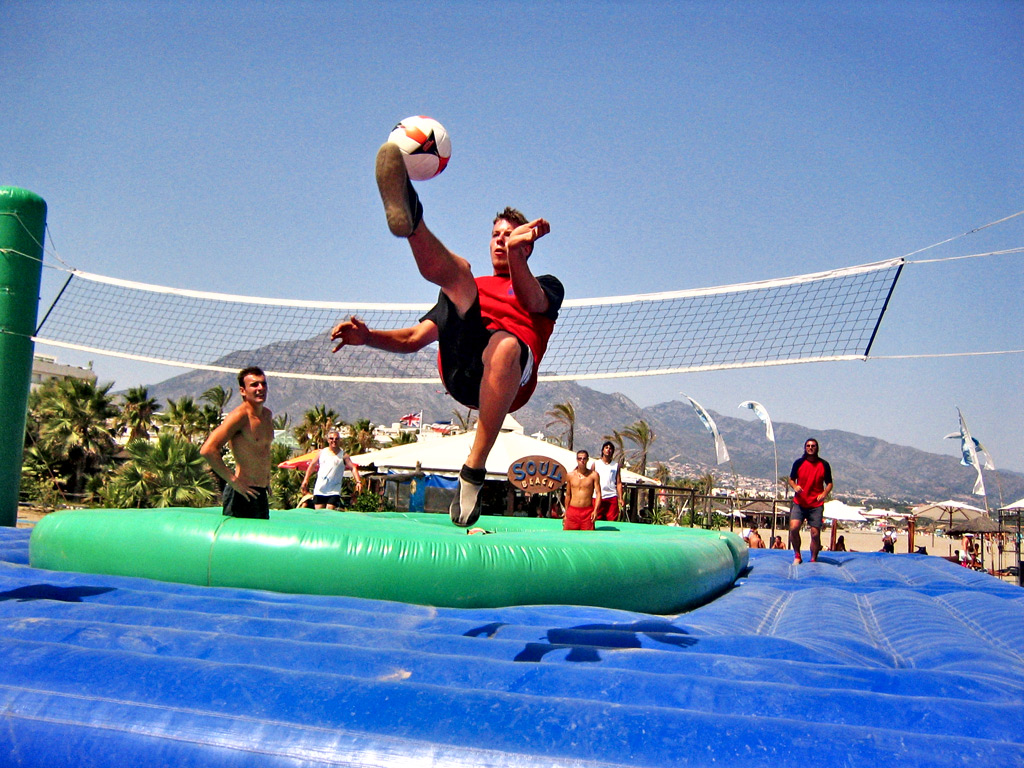by Sophie Isbister (Staff Writer)
 The leaves are turning, there’s a chill in the air and Christmas commercials are starting to pop up on television. But instead of focusing on the usual winter sports, my attention is on a summer sport. Imagine a sport that combines volleyball with trampolines, soccer with samba music and a little bit of the Brazilian martial arts dance Capoeira thrown in for show. Enter bossaball, a brand new sport invented in 2005 by a Belgian genius named Filip Eyckmans.
The leaves are turning, there’s a chill in the air and Christmas commercials are starting to pop up on television. But instead of focusing on the usual winter sports, my attention is on a summer sport. Imagine a sport that combines volleyball with trampolines, soccer with samba music and a little bit of the Brazilian martial arts dance Capoeira thrown in for show. Enter bossaball, a brand new sport invented in 2005 by a Belgian genius named Filip Eyckmans.
Bored of traditional volleyball, which adhered to conventionally stuffy laws like gravity and has an uninspired soundtrack, Eyckmans decided that the game would be better played in a giant bouncy-castle-type structure, with a trampoline on either side of the net. Instead of using just your hands like regular, boring volleyball, bossaball encourages players to use their feet as well. Oh, and the referee is a percussion-playing, record-spinning, funny-voiced samba king.
The word bossa in Portuguese means style or attitude, and that’s exactly what bossaball players aim to bring to the court. Players make the most of the bouncy court, with one of the more popular moves being a backwards over-head kick. Each side can play with three to five players on their team. One player from each squad, the spiker, plays on the trampoline, which is surrounded by cushy padding called the bossa wall. The aim is a lot like in volleyball: you want to spike the ball into your opponent’s court. In bossaball, you get three points if you hit the trampoline, one point if you hit elsewhere in the court and if you hit the bossa wall gameplay continues with no point being scored.
Real showmanship comes into play in bossaball because each team has up to eight passes between the players on each side before they must return the ball over the net. This allows for lots of tricks and allows the spiker, the trampoline attacker, to bounce high enough to eventually spike a pass from a teammate over the net. The net can vary in height depending on the skill level of those playing. The ball can be touched with any body part, and can even be touched twice in a row by the same player as long as the hands are not used both times.
Bossaball is a very accessible sport, to a point. The court is fun, cushy and bouncy. Players of all levels can enjoy bossaball. It’s definitely a party sport, but because of its patented court, it can’t be played anywhere or by just anyone. Because the court is expensive to rent and requires a lot of space and an elaborate setup, bossaball is usually played in conjunction with a corporate event, like the Pepsi Refresh Your World campaign or French Candy Company Haribo’s bossaball tournament. The sport is very new, and because of that it doesn’t have a mainstream following, although there are clubs in several European and South American countries.
Video clips of bossaball display stunning trampoline and gymnastic feats, but the overwhelming feeling you get watching the sport is that everyone is having a really good time. The contagious samba beat causes the players to dance while they play, and the spectators appear to not only be at a spectator sport, but also at a bangin’ beach party. The spirit and flavour of bossaball is admirable, and when you see people play it, you really want to join the party.


